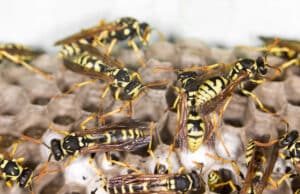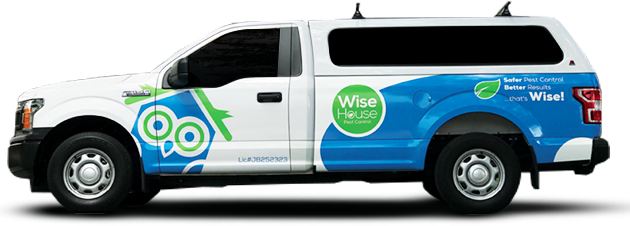Yellow jackets and wasps are common pests that can be aggressive and dangerous if disturbed. Although they are often confused with one another, these insects differ in physical characteristics, behaviors, and nesting habits. Understanding these differences is important for effective pest control and personal safety. We will look at the characteristics of yellow jackets and wasps, the dangers they pose, and how to prevent and eliminate infestations.

Yellow jackets are a type of wasp, known for their distinctive black-and-yellow markings and shiny bodies. This specie belong genus Vespula or Dolichovespula. Unlike bees, they lack the fine hairs used for pollen collection and have sleek, glossy exoskeletons. Queens can reach up to 0.75 inches in length, while the workers typically measure about 0.47 inches.
Although yellow jackets are often mistaken for honey bees due to their similar coloring, there are several differences. Yellow jackets have black antennae and a more aggressive behavior than honey bees. Additionally, yellow jackets do not have the furry bodies that bees use to gather pollen, and they have a more robust, compact shape
Yellow jackets also known as meat bees, are highly aggressive, particularly in late summer when their food sources dwindle. They feed on both sugars and proteins, scavenging for fruit, flower nectar, and human food waste. Yellow jackets are predatory and hunt other insects like flies, caterpillars, and spiders.
Yellow jackets build their nests underground, often in protected areas like soil cavities, old rodent burrows, or stumps. These nests are made of paper-like material, created from chewed-up wood fibers. A typical colony can grow to 4,000 to 5,000 workers, with nests containing up to 15,000 cells.
The life cycle of yellow jackets and wasps follows a consistent annual pattern. The stages involve the queen’s preparation for a new colony, the development of workers, and the eventual decline of the nest as winter approaches. Each phase is important for the survival and growth of these social insects.
The cycle begins in early spring when fertilized queens emerge from hibernation. These queens are the only members of the previous year’s colony that survive the winter. During the colder months, queens hibernate in sheltered areas like rotting logs, under bark, or inside building crevices
Once the weather warms, the queen comes out of hibernation and begins looking for a suitable nesting site. This could be underground for yellow jackets or in trees, eaves, or other elevated areas for many wasp species
After selecting a nesting location, the queen starts building a small paper nest by chewing up wood fibers and mixing them with her saliva. This nest initially contains 30 to 50 brood cells, where she lays the first batch of eggs. The queen alone tends to the eggs, which hatch into larvae after about 5 to 8 days
During this time, the queen forages for food, primarily feeding the larvae with chewed-up insects and other protein sources. The larvae undergo several molts before entering the pupal stage.
After 18-20 days in the larval stage, the pupae develop into adult workers. These workers are sterile females who take over the queen’s tasks of nest building, foraging, and caring for the young. By mid-summer, the first generation of workers emerges, allowing the queen to remain inside the nest and focus solely on laying eggs
The colony now expands rapidly, with workers adding new layers to the nest and foraging for food. A fully developed yellow jacket nest can house between 4,000 to 5,000 workers.
To reduce the likelihood of attracting yellow jackets and wasps, it’s important to eliminate food sources:
Wasps and yellow jackets can enter homes through small cracks or gaps. Seal any entry points around windows, doors, and roof eaves to prevent them from nesting inside your home.
Regularly trimming vegetation and removing piles of wood or debris can help prevent wasps from building nests around your home. Keep an eye on areas like attics and sheds, which can offer ideal nesting spots.
If you notice large numbers of yellow jackets or wasps around your property or see them entering hidden areas such as walls or attics, it’s time to call a professional. Large colonies can become highly aggressive and difficult to remove safely.
Attempting to remove large nests on your own is risky. Yellow jackets and wasps are highly territorial and will swarm to protect their nest if threatened. Professional pest control services have the necessary tools and safety measures to eliminate nests without provoking attacks.
No, unlike honey bees, yellow jackets and wasps can sting multiple times without dying. Their stingers do not have barbs, allowing them to sting repeatedly.
Yes, especially yellow jackets, which are more aggressive than most bees and will sting without much provocation. They are highly territorial and will defend their nests if they feel threatened.
Ensure garbage bins are sealed, remove food attractants like sugary foods, and maintain your yard to discourage nesting. Regularly trim vegetation and seal cracks or crevices in walls to prevent nesting.
While they don’t cause structural damage, their nests can be a nuisance. Large nests in attics or walls may be difficult to remove, especially if left unattended, and may require professional pest control.

Ready to send away pests without harming your pets? Getting started with Wise House Environmental Services is as easy as 1-2-3:
With Wise House Environmental Services, you get more than just effective pest control; you get peace of mind, knowing that your home is without pests and safer for your pets.
Our approach to pest control combines science with safety, offering you the kind of targeted, effective solutions that you won’t find with just any other pest control service. Our services have made a world of difference for homeowners, and we can do the same for you. Your pets will thank you for it!
We serve Port St. Lucie,Lake Worth, Boyton Beach, Palm Beachand the Treasure Coast.


© 2023 All Rights Reserved. | Sitemap